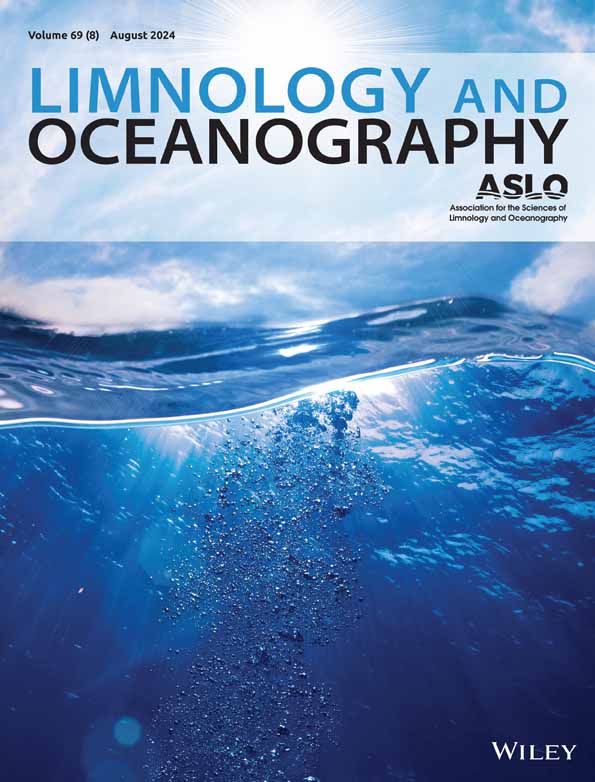雷德菲尔德重访:对淡水林碳、氮、磷化学计量学的洞察
IF 3.7
1区 地球科学
Q1 LIMNOLOGY
引用次数: 0
摘要
Seston碳(C)、氮(N)和磷(P)化学计量学在水生生态系统中起着重要作用,影响养分循环、初级和次级生产以及营养相互作用。在湖泊等淡水系统中,磷限制更为常见,而在海洋环境中,氮更频繁地限制初级生产,反映了水生生态系统中不同的营养限制模式。Redfield比值(C106: N16: P1摩尔比)是由海洋seston发展而来的,长期以来一直被认为是水生生态系统营养成分的基准和营养限制的预测指标。后来的全球淡水和海洋群落调查提出了Sterner比值(C166: N20: P1摩尔)作为更广泛的全球群落平均值。我们提出了一个完全重复的、多年的淡水生态实验的结果,该实验测试了不同资源氮磷化学计量对物种化学计量的影响。我们发现,在N限制条件下,群落C: N: P比值与Redfield比值一致,而P限制条件与Sterner全球淡水生态系统调查结果一致。三元图提供了对化学计量变化的直观洞察,显示了随着N: P供应增加,相对于C和N, P耗竭的趋势。从我们的实验数据中观察到的平均群落C: N: P比值为C141: N22: P1(摩尔),群落C: N: P与资源比值梯度相比变化较小。我们的中生态实验表明,Redfield比值提供了对氮限制淡水生态系统中物种化学计量的有用描述。这些发现促进了对群落C: N: P化学计量学自下而上控制的理解,并强调了在淡水生态系统中Redfield比值应用的生态学理论的完善必要性。本文章由计算机程序翻译,如有差异,请以英文原文为准。
Redfield revisited: Insights into freshwater seston carbon : nitrogen : phosphorus stoichiometry
Seston carbon (C), nitrogen (N), and phosphorus (P) stoichiometry plays a fundamental role in aquatic ecosystems, influencing nutrient cycling, primary and secondary production, and trophic interactions. In freshwater systems such as lakes, P limitation is more common, whereas in marine environments, N more frequently limits primary production, reflecting different nutrient limitation patterns across aquatic ecosystems. The Redfield ratio (C106 : N16 : P1 molar), developed from marine seston, has long been considered a benchmark for nutrient composition and a predictor of nutrient limitation across aquatic ecosystems. A later global freshwater and marine seston survey proposed the Sterner ratio (C166 : N20 : P1 molar) as a broader global seston average. We present the results of a fully replicated, multi‐annual freshwater mesocosm experiment testing the effect of variable resource N : P stoichiometry on seston stoichiometry. We found that the seston C : N : P ratio aligned with the Redfield ratio under N‐limited conditions, while P‐limited conditions aligned with the Sterner global survey of freshwater ecosystems. Ternary plots offered visual insight into stoichiometric shifts, showing a trend toward P depletion relative to C and N as N : P supply increases. The average seston C : N : P ratio observed from our experimental data was C141 : N22 : P1 (molar) and variation in seston C : N : P was small compared to the resource ratio gradient. Our mesocosm experiment showed that the Redfield ratio provides a useful description of seston stoichiometry in N‐limited freshwater ecosystems. These findings advance the understanding of bottom‐up controls on seston C : N : P stoichiometry and highlight the need to refine ecological theories regarding the application of the Redfield ratio in freshwater ecosystems.
求助全文
通过发布文献求助,成功后即可免费获取论文全文。
去求助
来源期刊

Limnology and Oceanography
地学-海洋学
CiteScore
8.80
自引率
6.70%
发文量
254
审稿时长
3 months
期刊介绍:
Limnology and Oceanography (L&O; print ISSN 0024-3590, online ISSN 1939-5590) publishes original articles, including scholarly reviews, about all aspects of limnology and oceanography. The journal''s unifying theme is the understanding of aquatic systems. Submissions are judged on the originality of their data, interpretations, and ideas, and on the degree to which they can be generalized beyond the particular aquatic system examined. Laboratory and modeling studies must demonstrate relevance to field environments; typically this means that they are bolstered by substantial "real-world" data. Few purely theoretical or purely empirical papers are accepted for review.
 求助内容:
求助内容: 应助结果提醒方式:
应助结果提醒方式:


